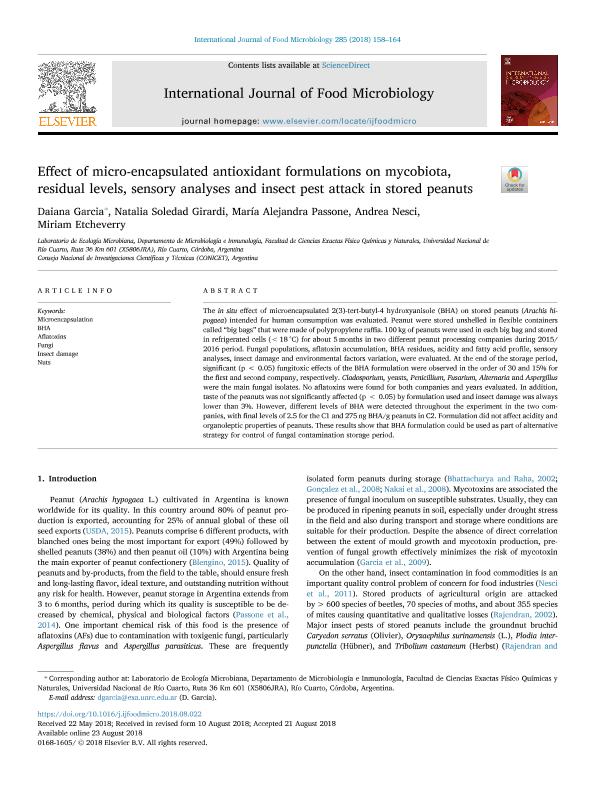Mostrar el registro sencillo del ítem
dc.contributor.author
García, Daiana

dc.contributor.author
Girardi, Natalia Soledad

dc.contributor.author
Passone, Maria Alejandra

dc.contributor.author
Nesci, Andrea Verónica

dc.contributor.author
Etcheverry, Miriam Graciela

dc.date.available
2020-12-02T14:59:29Z
dc.date.issued
2018-08-23
dc.identifier.citation
García, Daiana; Girardi, Natalia Soledad; Passone, Maria Alejandra; Nesci, Andrea Verónica; Etcheverry, Miriam Graciela; Effect of micro-encapsulated antioxidant formulations on mycobiota, residual levels, sensory analyses and insect pest attack in stored peanuts; Elsevier Science; International Journal of Food Microbiology; 285; 23-8-2018; 158-164
dc.identifier.issn
0168-1605
dc.identifier.uri
http://hdl.handle.net/11336/119611
dc.description.abstract
The in situ effect of microencapsulated 2(3)-tert-butyl-4 hydroxyanisole (BHA) on stored peanuts (Arachis hipogaea) intended for human consumption was evaluated. Peanut were stored unshelled in flexible containers called “big bags” that were made of polypropylene raffia. 100 kg of peanuts were used in each big bag and stored in refrigerated cells (<18 °C) for about 5 months in two different peanut processing companies during 2015/2016 period. Fungal populations, aflatoxin accumulation, BHA residues, acidity and fatty acid profile, sensory analyses, insect damage and environmental factors variation, were evaluated. At the end of the storage period, significant (p < 0.05) fungitoxic effects of the BHA formulation were observed in the order of 30 and 15% for the first and second company, respectively. Cladosporium, yeasts, Penicillium, Fusarium, Alternaria and Aspergillus were the main fungal isolates. No aflatoxins were found for both companies and years evaluated. In addition, taste of the peanuts was not significantly affected (p < 0.05) by formulation used and insect damage was always lower than 3%. However, different levels of BHA were detected throughout the experiment in the two companies, with final levels of 2.5 for the C1 and 275 ng BHA/g peanuts in C2. Formulation did not affect acidity and organoleptic properties of peanuts. These results show that BHA formulation could be used as part of alternative strategy for control of fungal contamination storage period.
dc.format
application/pdf
dc.language.iso
eng
dc.publisher
Elsevier Science

dc.rights
info:eu-repo/semantics/openAccess
dc.rights.uri
https://creativecommons.org/licenses/by-nc-sa/2.5/ar/
dc.subject
AFLATOXINS
dc.subject
BHA
dc.subject
FUNGI
dc.subject
INSECT DAMAGE
dc.subject
MICROENCAPSULATION
dc.subject
NUTS
dc.subject.classification
Biotecnología Agrícola y Biotecnología Alimentaria

dc.subject.classification
Biotecnología Agropecuaria

dc.subject.classification
CIENCIAS AGRÍCOLAS

dc.title
Effect of micro-encapsulated antioxidant formulations on mycobiota, residual levels, sensory analyses and insect pest attack in stored peanuts
dc.type
info:eu-repo/semantics/article
dc.type
info:ar-repo/semantics/artículo
dc.type
info:eu-repo/semantics/publishedVersion
dc.date.updated
2020-10-15T14:07:05Z
dc.journal.volume
285
dc.journal.pagination
158-164
dc.journal.pais
Países Bajos

dc.journal.ciudad
Amsterdam
dc.description.fil
Fil: García, Daiana. Universidad Nacional de Rio Cuarto, Facultad de Ciencias Exactas Fisicoquímicas y Naturales, Departamento de Microbiología e Inmunología, Cátedra de Ecología Microbiana; Argentina. Consejo Nacional de Investigaciones Científicas y Técnicas; Argentina
dc.description.fil
Fil: Girardi, Natalia Soledad. Universidad Nacional de Rio Cuarto, Facultad de Ciencias Exactas Fisicoquímicas y Naturales, Departamento de Microbiología e Inmunología, Cátedra de Ecología Microbiana; Argentina. Consejo Nacional de Investigaciones Científicas y Técnicas; Argentina
dc.description.fil
Fil: Passone, Maria Alejandra. Universidad Nacional de Rio Cuarto, Facultad de Ciencias Exactas Fisicoquímicas y Naturales, Departamento de Microbiología e Inmunología, Cátedra de Ecología Microbiana; Argentina. Consejo Nacional de Investigaciones Científicas y Técnicas; Argentina
dc.description.fil
Fil: Nesci, Andrea Verónica. Universidad Nacional de Rio Cuarto, Facultad de Ciencias Exactas Fisicoquímicas y Naturales, Departamento de Microbiología e Inmunología, Cátedra de Ecología Microbiana; Argentina. Consejo Nacional de Investigaciones Científicas y Técnicas; Argentina
dc.description.fil
Fil: Etcheverry, Miriam Graciela. Universidad Nacional de Rio Cuarto, Facultad de Ciencias Exactas Fisicoquímicas y Naturales, Departamento de Microbiología e Inmunología, Cátedra de Ecología Microbiana; Argentina. Consejo Nacional de Investigaciones Científicas y Técnicas; Argentina
dc.journal.title
International Journal of Food Microbiology

dc.relation.alternativeid
info:eu-repo/semantics/altIdentifier/url/https://linkinghub.elsevier.com/retrieve/pii/S0168160518305579
dc.relation.alternativeid
info:eu-repo/semantics/altIdentifier/doi/http://dx.doi.org/10.1016/j.ijfoodmicro.2018.08.022
Archivos asociados
